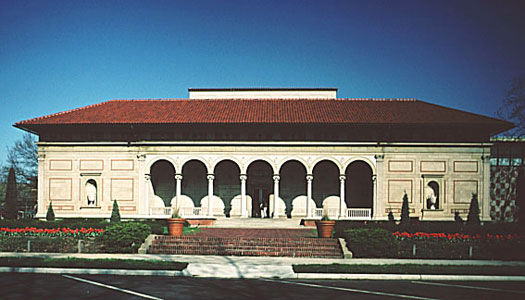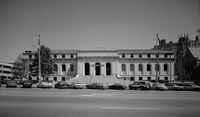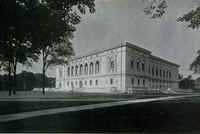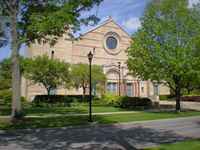Allen Memorial Art Museum
- Other Names:
- Oberlin Art Museum
- Location:
- 87 North Main Street, Oberlin, Ohio
- Design & Construction:
- 1915-1917 [1914-1917 Irish-1999; 1915-1917Christen-2001]
- Architect:
- Cass Gilbert
In 1915, Elisabeth Severance Allen (later Prentiss) made a gift to Oberlin College for the construction of an art museum, in memory of her husband, Oberlin alumnus Dr. Dudley Peter Allen. The Allens admired Gilbert's work on Finney Chapel (1905-1908), and Elizabeth remained closely involved with the museum throughout the design and construction. [Blodgett-1985 p. 26]
Gilbert's campus plan had called for three buildings on the east side of Tappan Square; the Art Museum is the only one of the three to be realized. [Blodgett-1985 p. 26]. The three buildings were to be open to the public, creating a bridge between campus and town. The Allen Memorial Art Museum has filled this role: the phrase, "The Cause of Art is the Cause of the People," is carved on the front facade; and admission is free and open to all. [Oberlin-AMAM-Guide]
The Art Museum is a mixture of Beaux-Art ideals and Italian Renaissance design. The building has the appearance of an Italian villa: strict symmetry, classical arches, lunettes, and a loggia supported by Corinthian columns. Gilbert makes use of the same, unified material palette that he employed in all of the buildings he designed for the Oberlin Campus (Finney Chapel, Cox Building, and the Theology Quadrangle). The hipped roof is clad with red terra-cotta tile and the stone walls are a warm sandstone, quarried locally. The one departure he made from this simple palette was the subtle addition of the color blue to the museum's facade. Splashes of blue appear in the frieze, the rafter extensions and in the vaults of the loggia. Gilbert fretted over the contrast, but ultimately decided that time would soften it. [Blodgett-1985 p. 26]
Because this was an art museum, the artistic elements of the building took on heightened importance. Gilbert took special care in supervising the details of construction of the museum. [Blodgett-1985 p. 26] Large stone niches flank the entrance. The custom ironwork was forged by master blacksmith Samuel Yellin. Allegorical and religious lunettes grace the entablature. The interior plan is organized around a central atrium, which was designed as the sculpture court.
In 1977 architects Robert Venturi, John Rauch, and Denise Scott Brown designed a post-modern addition to the building, incorporating the Ellen Johnson Gallery, named in honor of long-time Oberlin art historian and collector of modern art, and offices and work space for the museum staff.
See Also
-
Oberlin College Archives. Cass Gilbert Papers, 1903-1982." Oberlin College has a collection of papers related to Cass Gilbert's designs for the college. http://www.oberlin.edu/archive/holdings/finding/RG30/SG124/index.html
-
Allen Memorial Art Museum (website). http://www.oberlin.edu/amam/
-
Mary Ann Sullivan. "Digital Imaging Project" Bluffton University. Professor emerita Mary Ann Sullivan has published thousands of photographs of buildings of historic significance, including: the Arkansas State Capitol http://www.bluffton.edu/~sullivanm/westva/capitol/capitol.html; the Allen Memorial Museum http://www.bluffton.edu/~sullivanm/gilbert/allen.html; the St. Louis Art Museum http://www.bluffton.edu/~sullivanm/missouri/stlouis/artmuseum/gilbert.html and more.




